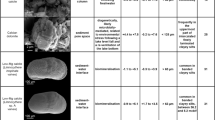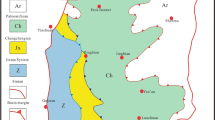Abstract
Most long palaeoclimatic records based on isotope studies have come from deep-sea cores; however, in order to obtain information on regional climatic variations, it is essential to study continental deposits. The chief limitation has been the lack of well-preserved datable geological records, with the exception of cave formations. We report here values for the stable carbon isotope ratio, 13C/12C, and the elemental carbon to nitrogen (C/N) ratio of the organic fraction of the palaeomagnetically and radiometrically dated Pleistocene Karewa lake sediments from Kashmir, India. Together, the two ratios, which are anticorrelated, provide an excellent marker of the source of organic matter in the lake. The Karewa sediments indicate at least three major episodes of shallower than normal levels. These episodes of shallow lake levels, and hence a cold, dry climatic regime, are broadly correctable with deep-sea records.
This is a preview of subscription content, access via your institution
Access options
Subscribe to this journal
Receive 51 print issues and online access
$199.00 per year
only $3.90 per issue
Buy this article
- Purchase on Springer Link
- Instant access to full article PDF
Prices may be subject to local taxes which are calculated during checkout
Similar content being viewed by others
References
De Terra, H. & Paterson, T. T. Studies on the Ice Age in India and Associated Human Cultures (Carnegie Institute, Washington, 1939).
Agrawal, D. P. et al. Acta geol. hung. 22, 185–196 (1979).
Singh, I. B. J. palaeont. Soc. India 27, 71–110 (1982).
Agrawal, D. P. in Climate and Geology of Kashmir and Central Asia. The Last Four Million Years (eds Agrawal, D. P., Kusumgar, S. & Krishnamurthy, R. V.) 1–12 (Today's & Tomorrow's, New Delhi, 1985).
Burbank, D. W. & Johnson, G. D. Nature 298, 432–436 (1982).
Gupta, H. P. et al. Climate Climate and Geology of Kashmir and Central Asia. The Last Four Million Years (eds Agrawal, D. P., Kusumgar, S. & Krishnamurthy, R. V.) 101–108 (Today's and Tomorrow's, New Delhi, 1985).
Krishnamurthy, R. V., DeNiro, M. J. & Pant, R. K. Nature 298, 640–641 (1982).
Dodia, R., Agrawal, D. P. & Vora, A. B. in Climate and Geology of Kashmir and Central Asia. The Last Four Million Years (eds Agrawal, D. P., Kusumgar, S. & Krishnamurthy, R. V.) 13–17 (Today's and Tomorrow's, New Delhi, 1985).
Tandon, S. K., Pant, R. K. & Korisettar, R. Man Envir. 6, 6–10 (1982).
Burbank, D. W. & Johnson, G. D. Palaeogeogr. Palaeoclimatol. Palaeoecol. 43, 205–235 (1983).
Burbank, D. W. & Grant, M. J. Z. Gletscherk GlazialgeoL 21, 229–236 (1985).
Kusumgar, S., Agrawal, D.P. & Kotlia, B.S. in Climate and Geology of Kashmir and Central Asia, The Last Four Million Years (eds Agrawal, D. P., Kusumgar, S. & Krishnamurthy, R. V.) 13–17 (Today's and Tomorrow's, New Delhi, 1985).
Kusumgar, S., Bhandari, N. & Agrawal, D. P. in Climate and Geology of Kashmir and Central Asia. The Last Four Million Years (eds Agrawal, D. P., Kusumgar, S. & Krishnamurthy, R. V.) 245–247 (Today's & Tomorrow's, New Delhi, 1985).
Mankinen, E. A. & Dalrymple, G. B. J. geophys. Res. 84, 615–626 (1979).
Stuiver, M. Quat. Res. 5, 251–262 (1975).
Smith, B. N. & Epstein, S. PI. Physiol. 47 380–384 (1971).
O'Leary, M. H. Phytochemistry 20, 553–567 (1981).
Hakansson, S. Quat. Sci. Rev. 4, 135–146 (1985).
Buchardt, B. & Fritz, P. in Handbook of Environmental Isotope Geochemistry: The Terrestrial Environment A (eds Fritz, P. & Fontes, J.) 473–504 (Elsevier, Amsterdam, 1980).
Nakai, N. Proc. Japan Acad. 48, 516–521 (1972).
Stiller, M. preprint.
Nakai, N. preprint, Nagoya Univ. (1982).
Nakai, N. et al. Daiynki–Kenkyu (in the press).
Meybeck, M. Am. J. Sci. 282, 401–450 (1982).
Leenheer, M. J. & Meyers, P. A. in Advances in Organic Geochemistry, 1981 (eds Bjoroy, M. et al.) 309–316 (Wiley, London, 1983).
Debyser, Y., Monvozier, L. J., Santvoit, D. & Daumas, R. in Advances in Organic Geochemistry, 1981 (eds Bjoroy, M. et al.) 259–267 (Wiley, London, 1983).
Milliman, D. J. & Quinchun, Xu Am. J. Sci. 284, 824–834 (1984).
Shackleton, N. J. & Opdyke, N. D. Quat. Res. 3, 39–55 (1973).
Shackleton, N. J. & Opdyke, N. D. Nature 270, 216–219 (1977).
Shackleton, N. J. et al. Nature 307, 620–623 (1984)
Author information
Authors and Affiliations
Rights and permissions
About this article
Cite this article
Krishnamurthy, R., Bhattacharya, S. & Kusumgar, S. Palaeoclimatic changes deduced from 13C/12C and C/N ratios of Karewa lake sediments, India. Nature 323, 150–152 (1986). https://doi.org/10.1038/323150a0
Received:
Accepted:
Issue Date:
DOI: https://doi.org/10.1038/323150a0
This article is cited by
-
Climate change record of Qiongduojiang Basin in Southern Qinghai-Tibet Plateau during 40.4~30.0 cal ka BP
Arabian Journal of Geosciences (2023)
-
Ecological and hydrologic evolution history in the sensitive zone of both East Asian summer monsoon and Westerly since the Last Glacial Maximum
Journal of Mountain Science (2023)
-
A 1000-year hydroclimate record from the Asian summer monsoon-Westerlies transition zone in the northeastern Qinghai-Tibetan Plateau
Climatic Change (2023)
-
Geoheritage Sites of Quaternary Loess–Palaeosol and Palaeo-fluvio-lacustrine Deposits in Northwest Himalaya: a Necessitate Protection
Geoheritage (2022)
-
Impact of climate on the evolution of vegetation in tectonically active Karewa basin, Kashmir Himalayas
Journal of Earth System Science (2021)
Comments
By submitting a comment you agree to abide by our Terms and Community Guidelines. If you find something abusive or that does not comply with our terms or guidelines please flag it as inappropriate.



